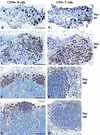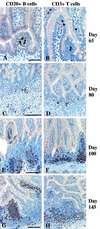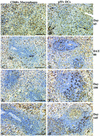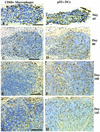Functional and morphological development of lymphoid tissues and immune regulatory and effector function in rhesus monkeys: cytokine-secreting cells, immunoglobulin-secreting cells, and CD5(+) B-1 cells appear early in fetal development
- PMID: 12522052
- PMCID: PMC145291
- DOI: 10.1128/cdli.10.1.140-153.2003
Functional and morphological development of lymphoid tissues and immune regulatory and effector function in rhesus monkeys: cytokine-secreting cells, immunoglobulin-secreting cells, and CD5(+) B-1 cells appear early in fetal development
Abstract
Little is known regarding the timing of immune ontogeny and effector function in fetal humans and nonhuman primates. We studied the organization of lymphocyte and antigen-presenting cell populations in developing lymphoid tissues of rhesus monkey fetuses during the second and third trimesters (65 to 145 days of gestation; term = 165 days). Immunoglobulin-secreting and cytokine-secreting cells were detected at day 80. The thymus, spleen, lymph nodes, and intestinal mucosa were examined for cells expressing CD3, CD5, CD20, CD68, p55, and HLA-DR. In the spleens of 65-day-old fetuses (early second trimester), the overwhelming majority of total lymphocytes were CD5(+) CD20(+) B-1 cells. The remaining lymphocytes were CD3(+) T cells. By day 80, splenic B and T cells were equal in number. Intraepithelial CD3(+) CD5(-) T cells and lamina propria CD20(+) CD5(+) B cells were present in the intestines of 65-day-old fetuses. By day 80, numerous CD20(+) CD5(+) B cells were present in the jejunums and colons and early lymphocyte aggregate formation was evident. The spleens of 80- to 145-day-old fetuses contained immunoglobulin M (IgM)-secreting cells, while IgA-, IgG-, interleukin-6-, and gamma interferon-secreting cells were numerous in the spleens and colons. Thus, by the second trimester, the lymphoid tissues of the rhesus monkey fetus have a complete repertoire of properly organized antigen-presenting cells, T cells, and B cells.
Figures








References
-
- Ahluwalia, B., B. Wesley, O. Adeyiga, D. M. Smith, A. Da-Silva, and S. Rajguru. 2000. Alcohol modulates cytokine secretion and synthesis in human fetus: an in vivo and in vitro study. Alcohol 21:207-213. - PubMed
-
- Attanasio, R., J. S. Allan, S. A. Anderson, T. C. Chanh, and R. C. Kennedy. 1991. Anti-idiotypic antibody response to monoclonal anti-CD4 preparations in nonhuman primate species. J. Immunol. 146:507-514. - PubMed
-
- Bhat, N. M., A. B. Kantor, M. M. Bieber, A. M. Stall, L. A. Herzenberg, and N. N. Teng. 1992. The ontogeny and functional characteristics of human B-1 (CD5+ B) cells. Int. Immunol. 4:243-252. - PubMed
Publication types
MeSH terms
Substances
Grants and funding
LinkOut - more resources
Full Text Sources
Medical
Research Materials
Miscellaneous

